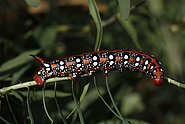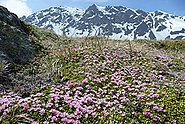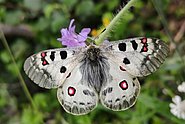Kempel, A., C.N. Bornand, A. Gygax, P. Juillerat, M. Jutzi, L. Sager, B. Bäumler, S. Eggenberg & F. Fischer. 2020. Nationwide re-visitation reveals thousands of local extinctions among 713 endangered plant species. Conservation Letters. DOI: 10.1111/conl.12749
Schäfer, D., H. Vincent, M. Fischer & A. Kempel. 2020. Experimental introductions of eight rare and endangered plant species into the wild and the importance of genetic diversity for their success. Global Ecology and Conservation. 10.1016/j.gecco.2020.e01240
Narimanov, N., Kempel, A., van Kleunen, M. & M. Entling. 2020. Unexpected sensitivity of the highly invasive spider Mermessus trilobatus (Emerton, 1882) to soil disturbance. Biological Invasions.
Vincent, H., C. N. Bornand, A. Kempel*°, and M. Fischer*. 2020. Rare species perform worse than widespread species under changed climate. Biological Conservation 246:108586. *Shared last authorship, °Corresponding author.
Kempel, A., H. Vincent, D. Prati, and M. Fischer. 2020. Context dependency of biotic interactions and its relation to plant rarity. Diversity and Distributions. 10.1111/ddi.13050
Cappelli, S. L., N. A. Pichon, A. Kempel, and E. Allan. 2020. Sick plants in grassland communities: a growth defense trade-off is the main driver of fungal pathogen abundance. Ecology Letters. 10.1111/ele.13537
Kattge, J., G. Bönisch, S. Díaz, … , A. Kempel, et al. 2020. TRY plant trait database – enhanced coverage and open access. Global Change Biology 26, 119–188.
Fanin, N., P. Kardol, M. Farrell, A. Kempel, M. Ciobanu, MC. Nilsson, MJ. Gundale, and DA Wardle. 2019. Effects of plant functional group removal on structure and function of soil communities across contrasting ecosystems. Ecology Letters 22, 1095-1103.
Malecore, E. M., W. Dawson, A. Kempel, G. Müller, and M. van Kleunen. 2018. Nonlinear effects of phylogenetic distance on early-stage establishment of experimentally introduced plants in grassland communities. Journal of Ecology 0, 1–13.
Soliveres, S., A. Lehmann, S. Boch, F. Altermatt, F. Carrara, T. W. Crowther, M. Delgado-Baquerizo, A. Kempel, D. S. Maynard, M. C. Rillig, B. K. Singh, P. Trivedi, and E. Allan. 2018. Intransitive competition is common across five major taxonomic groups and is driven by productivity, competitive rank and functional traits. Journal of Ecology 106, 852–864.
Kempel, A., A. Rindisbacher, M. Fischer, and E. Allan. 2018. Plant soil feedback strength in relation to large-scale plant rarity and phylogenetic relatedness. Ecology 99, 597–606.
Kempel, A., M. Razanajatovo, C. Stein, S. B. Unsicker, H. Auge, W. W. Weisser, M. Fischer, and D. Prati. 2015. Herbivore preference drives plant community composition. Ecology 96, 2923–2934.
Kempel, A., T. Chrobock, M. Fischer, R. P. Rohr, and M. van Kleunen. 2013a. Determinants of plant establishment success in a multispecies introduction experiment with native and alien species. Proceedings of the National Academy of Sciences 110:12727.
Kempel, A., P. Nater, M. Fischer, and M. van Kleunen. 2013b. Plant-microbe-herbivore interactions in invasive and non-invasive alien plant species. Functional Ecology 27:498–508.
Chrobock, T., A. Kempel, M. Fischer, and M. van Kleunen. 2011. Introduction bias: Cultivated alien plant species germinate faster and more abundantly than native species in Switzerland. Basic and Applied Ecology 12:244–250.
Kempel, A., M. Schädler, T. Chrobock, M. Fischer, and M. van Kleunen. 2011. Tradeoffs associated with constitutive and induced plant resistance against herbivory. Proceedings of the National Academy of Sciences 108:5685.
Kempel, A., A. K. Schmidt, R. Brandl, and M. Schädler. 2010. Support from the underground: Induced plant resistance depends on arbuscular mycorrhizal fungi. Functional Ecology 24:293–300.
Schädler, M., R. Brandl, and A. Kempel. 2010a. “Afterlife” effects of mycorrhization on the decomposition of plant residues. Soil Biology and Biochemistry 42:521–523.
Schädler, M., R. Brandl, and A. Kempel. 2010b. Host plant genotype determines bottom-up effects in an aphid-parasitoid-predator system. Entomologia Experimentalis et Applicata 135:162–169.
Kempel, A., R. Brandl, and M. Schädler. 2009. Symbiotic soil microorganisms as players in aboveground plant–herbivore interactions – the role of rhizobia. Oikos 118:634–640.
Kempel, A., H. Auge & E. Allan. Enemy impact on plant communities in a changing world. Preprint.org. Preprints ID: preprints-24012




